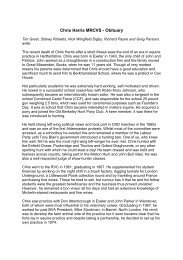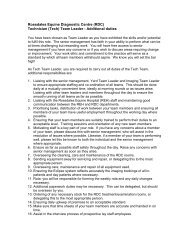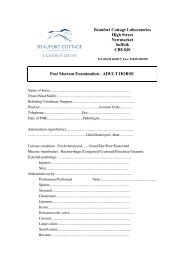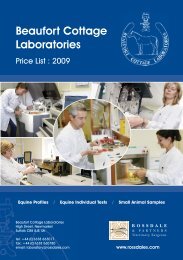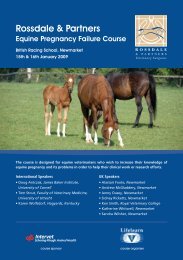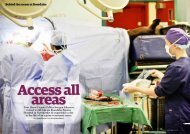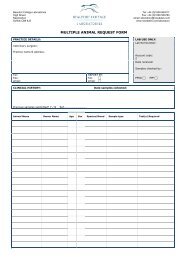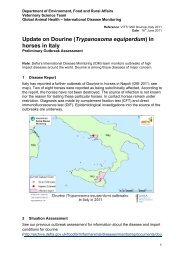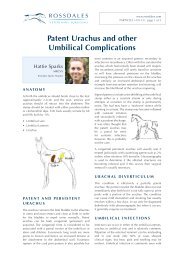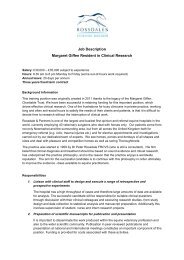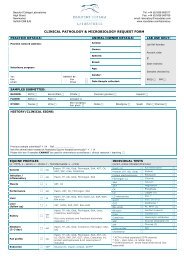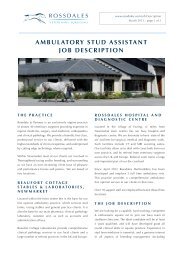EQUINE CLINICAL PATHOLOGY - Rossdale & Partners
EQUINE CLINICAL PATHOLOGY - Rossdale & Partners
EQUINE CLINICAL PATHOLOGY - Rossdale & Partners
Create successful ePaper yourself
Turn your PDF publications into a flip-book with our unique Google optimized e-Paper software.
T h e B e a u f o r t c o t t a g e l a b o r a t o r i e s<br />
biopsy sampling<br />
Skin Biopsy<br />
These are best obtained by full-thickness<br />
wedge incision. While skin punch biopsy<br />
techniques may be simpler to obtain,<br />
they are seldom as rewarding to examine.<br />
Tissues obtained should be fixed<br />
immediately in 10% formol saline.<br />
Lump biopsy<br />
Biopsy is recommended for masses that<br />
appear in or under the skin and sometimes<br />
for deeper masses that may be palpated<br />
or imaged by ultrasound or laparoscopic<br />
examination. If a total lesion resection is<br />
not possible, as is the case for many skin<br />
and subcutaneous masses, representative<br />
biopsies are best obtained by full-thickness<br />
wedge incision, and fixed immediately in<br />
10% formol saline.<br />
Liver Biopsy<br />
Liver biopsy is recommended where serum<br />
biochemical examinations have suggested<br />
hepatic pathology. With the horse restrained<br />
standing, ideally in stocks, the liver on the<br />
right side of the horse is examined with<br />
ultrasound to determine the ideal site<br />
for puncture and to detect signs of gross<br />
pathology, e.g. choleliths or Echinococcus<br />
spp. cysts.<br />
Biopsies are best obtained with a 6' 'Trucut'<br />
biopsy needle inserted between the<br />
14th and 15th ribs, on the right side of the<br />
horse, along a straight line drawn between<br />
the point of the hip and the shoulder,<br />
or elsewhere, if suggested by ultrasound<br />
examination. Specific lesion biopsies are<br />
best obtained by ultrasound guidance. The<br />
tissue sample should be carefully removed<br />
from the needle and fixed in 10% formol<br />
saline. The needle channel should then be<br />
carefully swabbed for bacterial culture.<br />
Lung Biopsy<br />
Lung biopsy may be indicated where there<br />
is clear ultrasonic evidence of pulmonary<br />
pathology. As biopsy of a lung abscess<br />
or focus of infection is contraindicated,<br />
evidence should suggest neoplasia or<br />
focal non-septic pathology before biopsy<br />
is attempted. Pulmonary neoplasia is very<br />
rare in horses so lung biopsy is seldom<br />
indicated.<br />
Needles specifically designed for lung<br />
biopsy should be used and the specific<br />
lesion to be biopsied should be imaged by<br />
ultrasound scan examination. The overlying<br />
intercostal skin site identified, infiltrated<br />
with local anaesthetic and clipped and<br />
prepared as for surgical intervention. With<br />
the transducer coupled in a sterile surgical<br />
glove and sterile coupling gel on its surface,<br />
the lung lesion is imaged and a lung biopsy<br />
device is introduced through the skin and<br />
into the lesion to collect the biopsy.<br />
The tissue sample is fixed in 10% formol<br />
saline without delay and the needle channel<br />
may, if required, be swabbed immediately<br />
for bacterial culture.<br />
52



